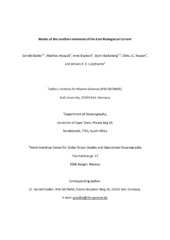Modes of the southern extension of the East Madagascar Current
Siedler, G.; Rouault, M.; Biastoch, A.; Backeberg, Bjørn C.; Reason, Chris J.C.; Lutjeharms, J. R. E.
Journal article
Permanent lenke
https://hdl.handle.net/1956/2841Utgivelsesdato
2008-11-04Metadata
Vis full innførselSamlinger
Originalversjon
https://doi.org/10.1029/2008jc004921Sammendrag
Data sets from satellite observations and a nested high‐resolution model are used to study a source region of the Agulhas Current. Altimeter‐derived geostrophic surface currents are averaged over varying periods, providing evidence of the persistence of flow patterns in the extension of the southern branch of the East Madagascar Current (SEMC). South of Madagascar, the SEMC separates into one branch towards the Agulhas Current and into a second branch retroflecting and connecting to the Subtropical Indian Ocean Countercurrent (SICC). Good agreement is found between long‐term mean patterns of observational and model dynamic heights. Two basic modes are identified in the SEMC extension, with anticyclonic motion favoring retroflection in the northern Mozambique Basin when the extension is in a south‐westward direction and cyclonic motion occurring in the case of the SEMC flowing westward along the southern Madagascar slope. A cross‐correlation sequence between model SEMC transports and the modal changes in the extension region displays a correlation at about one‐month lag which agrees with eddy propagation time from the SEMC to the outflow region. Mean model SEMC transports are determined using floats released at 21°S, and the contribution of the SEMC to the SICC is obtained using floats injected at 55°E with the model running backwards. Almost half of the SEMC volume transport contributes to the Agulhas system, and about 40% of SICC water originates from the SEMC.
